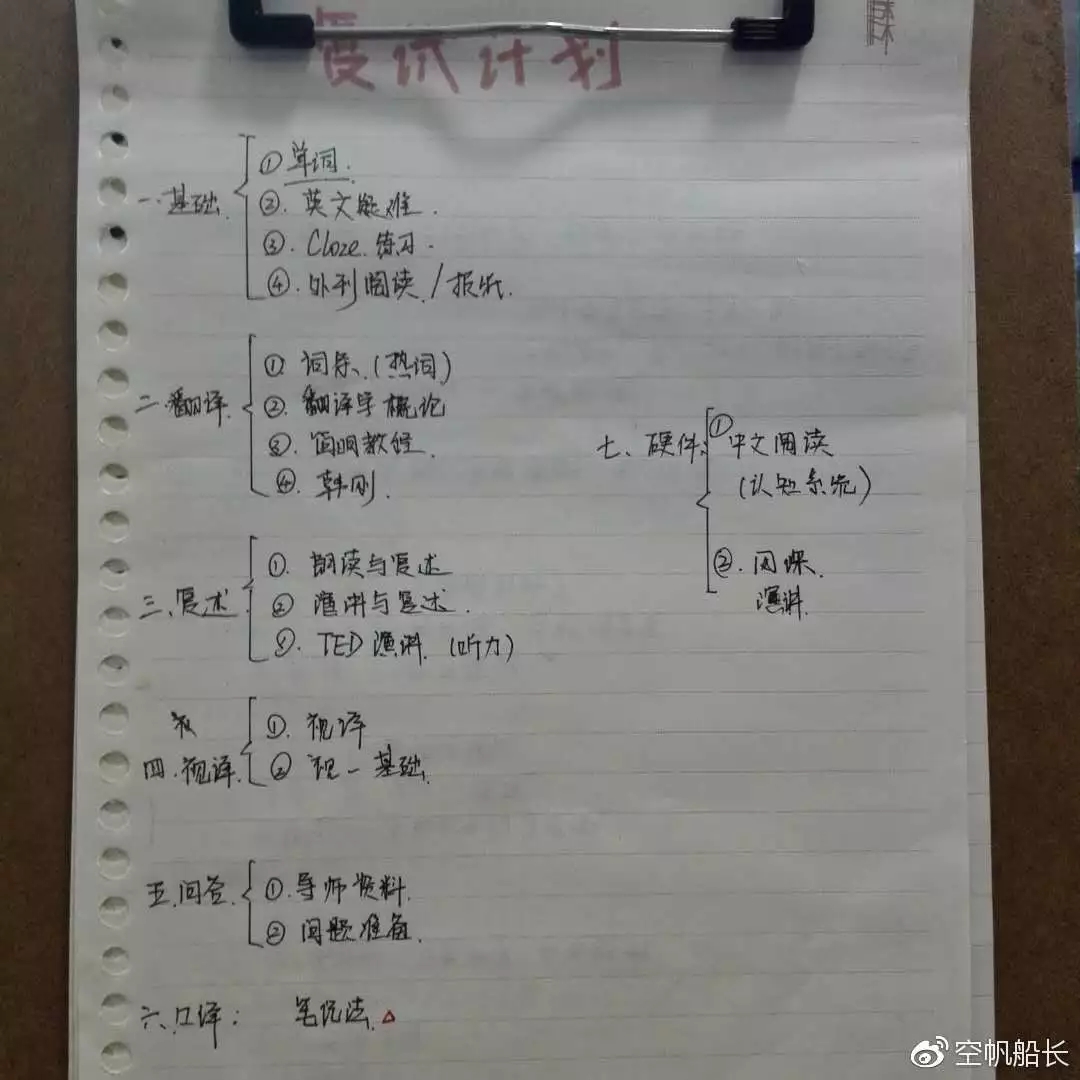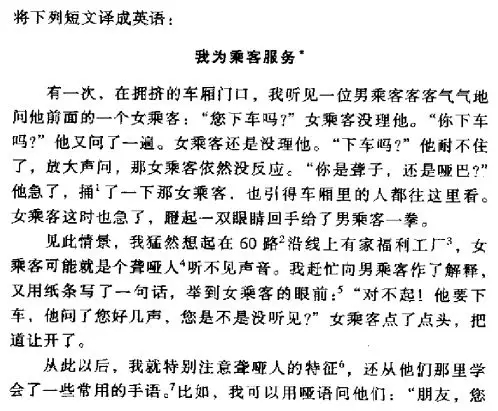
先说结果:
笔试75,面试89。
准备工作
一共用了100小时。一月主要看了一些时间管理、笔记术方面的书,大概有20本。二月过年基本没有复习过,到三月才真正准备复试。
下面是复试计划

3月30号——报到
带上你的资料(往届生就带了身份证、学历证、学位证原件复印件、复试通知书)到六教某个教室,让学姐检查一遍就ok,全程不到10分钟。然后会给你一张复试安排表。
注意:复试通知书带两份,一份交给学姐,另一份随身带着,笔试面试都要用到。
报到的教室门口会贴一个QQ群的二维码,所有MTI 复试生都会加到一个群里。报完到就没什么事情了,可以去看看学校环境。
3月31号——笔试+心理测试
9:00-12:00 笔试。题型是Cloze+英译中+中译英,满分100。
1.Cloze 30分。
一共30个空,给30个单词,需要变形。今年的题目比较难...用了一个小时还多,结果对完答案也不是很理想。及格万岁吧。
【undoubtedly, represent, livelihood, filled, variation, less, intensive, experience, include, exclude, household, level, manufacturing, avail, compete, need, hazard, sector, adjustment, exclusive, security, participate, access, increase, decline, care, prescribe, economic, rank, compel】
More and more women are now joining the paid labor force world-wide. They represent the majority of the workforce in all the _______ which are expanding as a result of globalization and trade liberalization—the informal sector, ________ subcontracting; export processing or free trade zones; homeworking; and the “flexible”, part-time, temporary, low-paid labor force. Even in countries which have low _______of women paid workers, such as the Arab countries, employment is rising.
In South-East Asia, women ________ up to 80 per cent of the workforce in the export processing zones, working mainly in the labor- _______ textile, toy, shoe and electronic sectors. In Latin American and the Caribbean, 70 per cent of _______ active women are employed in services. Many women in South-East Asia are moving from ________ into services.
Long _____ from many paid jobs and thus economically dependent on husbands or fathers, paid employment has ______ brought economic and social gains to many women. For many previously______ young women, the opportunity to gain financial independence, albeit limited and possibly temporary, has helped break down some of the taboos of their societies and______ on women’s behavior.
Any gains, however, should be seen in a wider context. _______ economic and social conditions throughout the world, in particular declining household incomes, have _______ many women to take any kind of paid work to meet their basic _______ and those of their families. The jobs _______ to them are, in the main, insecure and low-paid with irregular hours, high levels of intensity, little protection from health and safety _______ and few opportunities for promotion.
Women’s high ________ in informal employment is partly due to the fact that many jobs in the formal economy are not open to them: they are actively excluded from certain kinds of work or lack _______ to education and training or have domestic commitments. The _______ of women’s participation in the informal sector has been most marked in the countries of Sub-Saharan Africa where sharp economic decline and structural _______ policies have reduced the official job market drastically. As domestic markets are opened up to international ________ and quotas which restricted the quantity of imports from any one country are abandoned, cheap, subsidized foreign imports are threatening the _______ of many women small producers and entrepreneurs in “cottage industries”. In countries such as India and Bangladesh, for instance, more than 90 per cent of economically-active women work in the informal sector at jobs such hand loom weaving.
In general, women are paid ________ than men are, and women’s jobs pay less than men’s jobs. On average, most women earn 50 to 80 per cent of men’s pay, but there are considerable ______. In Tanzania, which _______ first in the world for pay equality, women earn 92 per cent of what men earn; in Bangladesh, they earn 42 per cent. Women also have less job _________ and fewer opportunities for promotion. Higher status jobs, even in industries which employ mostly women, tend to be ______ by men.
In addition, women usually have to continue their unpaid domestic and ________ work, such as of children, the sick and the elderly, which is often regarded as women’s “natural” and ________ responsibility. Even when they have full-time jobs outside the home, women take care of most _______ tasks, particularly the preparation of meals, cleaning and child care.
2.英译中(下面给出的是前半部分,后面没找到)
Modernization and economic development neither require nor produce cultural westernization. To the contrary, they promote a resurgence of, and renewed commitment to, indigenous cultures. At the individual level, the movement of people into unfamiliar cities, social settings, and occupations breaks their traditional local bonds, generates feelings of alienation and anomie, and creates crises of identity to which religion frequently provides an answer. At the societal level, modernization enhances the economic wealth and military power of the country as a whole and encourages people to have confidence in their heritage and to become culturally assertive. As a result, many non-Western societies have seen a return to indigenous cultures. It often takes a religious form, and the global revival of religion is a direct consequence of modernization. In non-Western societies this revival almost necessarily assumes an anti-Western cast, in some cases rejecting Western culture because it is Christian and subversive, in others because it is secular and degenerate. The return to the indigenous is most marked in Muslim and Asian societies. The Islamic Resurgence has manifested itself in every Muslim country.
East Asian societies have gone through a parallel rediscovery of indigenous values.For several centuries they, along with other non-Western peoples, envied the economic prosperity, technological sophistication, military power, and political cohesion of Western societies. They sought the secret of this success in Western practices and customs, and when they identified what they thought might be the key they attempted to apply it in their own societies. Now, however, a fundamental change has occurred. Today East Asians attribute their dramatic economic development not to their import of Western culture but to their adherence to their own culture. They have succeeded, they argue, not because they became like the West, but because they have remained different from the West. Now that they are no longer weak but instead increasingly powerful, they denounce as \"human rights imperialism\" the same values they previously invoked to promote their interests. As Western power recedes, so too does the appeal of Western values and culture, and the West faces the need to accommodate itself to its declining ability to impose its values on non-Western societies. In fundamental ways, much of the world is becoming more modern and less Western.
3.中译英
出的是庄绎传《英汉翻译简明教程》p19这篇文章。一模一样。同学们!看书要认真啊~~~~~


14:00-15:00 心理测试
在电脑上答题,5分钟搞定。这个不计入复试分数。
4月1号 面试
MA 7:45签到,MTI 8:45签到。
签到是在一个大阶梯室,已经提前分好组了。今年MTI(口译+笔译)有14组,每组10-11人。
要记得自己的组号和编号。
每一组的1号是第一批入场,2号第二批,以此类推。分组应该是按照初试排名来的,所以排名越前就越早进去面试。
签完到就放下手机和包包,带上你的纸质资料,挑个位置坐着开始等。
等待的时间还挺长的,我是1号,也等到了10点多。所以一定要带点东西去看啊,不然就只能像我一样傻坐着。
ok,老师点名了,“所有的1号带上你们的东西,准备过去面试”,然后我们就排着队跟着一个学姐走。
首先到一个语音室,先给你3分钟看视译材料(不能做笔记),然后看复述视频(可以做笔记)。
看完视频走出语音室,会看到好多个学姐好像来接机一样,举着张A4纸,上面写着组号。找到属于你的学姐(误),她会带着你走到面试的教室门口。
深呼一口气,准备进去面对考官。
考官有3个,我碰到的是一个女老师,两个男老师(没认出来)。
女老师非常和蔼可亲,男老师板着个脸,估计是故意的,考验下我的心理素质哈哈哈。
1. 复述。今年很简单,逻辑清晰,没有口音。复述材料是speech repository上的一段视频"advantages and disadvantages on hitchhiking"。
2. 视译。英译中是呼吁unity的演讲,中译英是有关金砖五国的内容,有数字。难度都不算大,感觉老师没有很认真听。注意不要太卡就好了。
3. 问答。问了我一些很常规的问题,事后跟小伙伴交流发现大家都差不多。问了我:
1:你的优势是什么?
2:缺点是什么?
3:学翻译的困难是什么?
4:了解广外mti的什么?
有的小伙伴被问到:
1:最近有读什么新闻吗?简单说一说
2:口译还是笔译?了解高翻院的翻译项目吗?
3:如果见到许渊冲大师,会问他什么问题?为什么?
4:做过翻译实践吗?
全程大概15-20分钟吧,注意语速不要太快,不然会越来越紧张。
下午自由活动,可以跟小伙伴去广州逛一逛,庆祝一下。
4月2号 体检
7:00-11:30
所有专业都是这一天体检,错开高峰很重要。
带上40元,空腹去。项目有:身高体重、血压、胸透、抽血、视力、内科。
体检完就彻底结束,可以回家了。
矫情的话就不说了。考研不是全部,只是人生的一个小插曲,需要持续努力才行~大家都加油。










